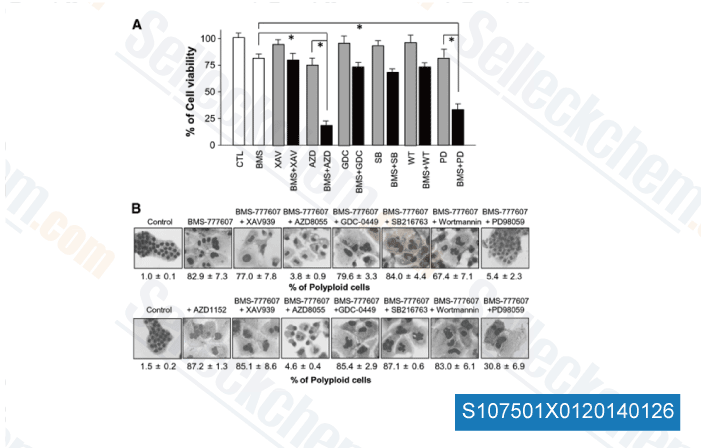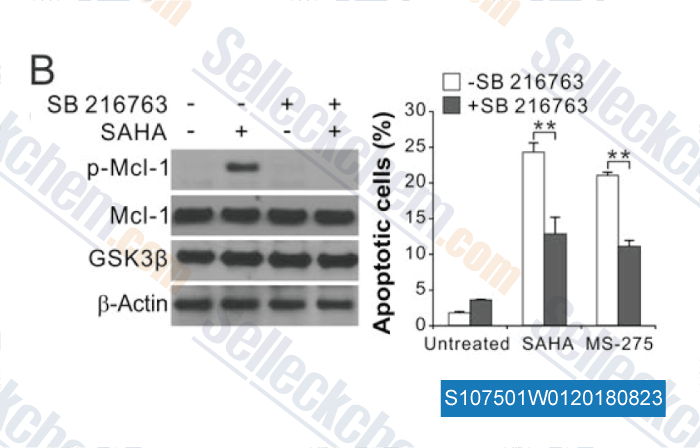|
Toll Free: (877) 796-6397 -- USA and Canada only -- |
Fax: +1-832-582-8590 Orders: +1-832-582-8158 |
Tech Support: +1-832-582-8158 Ext:3 Please provide your Order Number in the email. |
Technical Data
| Formula | C19H12N2O2Cl2 |
||||||
| Molecular Weight | 371.22 | CAS No. | 280744-09-4 | ||||
| Solubility (25°C)* | In vitro | DMSO | 23 mg/mL (61.95 mM) | ||||
| Water | Insoluble | ||||||
| Ethanol | Insoluble | ||||||
| In vivo (Add solvents to the product individually and in order) |
|
||||||
|
* <1 mg/ml means slightly soluble or insoluble. * Please note that Selleck tests the solubility of all compounds in-house, and the actual solubility may differ slightly from published values. This is normal and is due to slight batch-to-batch variations. * Room temperature shipping (Stability testing shows this product can be shipped without any cooling measures.) |
|||||||
Preparing Stock Solutions
Biological Activity
| Description | SB216763 is a potent and selective GSK-3 inhibitor with IC50 of 34.3 nM for GSK-3α and equally effective at inhibiting human GSK-3β. This compound activates autophagy. | ||||
|---|---|---|---|---|---|
| Targets |
|
||||
| In vitro | SB 216763 displays similar potency for GSK-3β with 96% inhibition at 10 μM while exhibiting minimal activity against 24 other protein kinases including PKBα and PDK1 with IC50 of >10 μM. This compound stimulates glycogen synthesis in human liver cells with EC50 of 3.6 μM, and induces dose-dependent transcription of a β-catenin-LEF/TCF regulated reporter gene in HEK293 cells with a maximum 2.5-fold induction at 5 μM. [1] It protects the cerebellar granule neurones from apoptotic cell death induced by LY-294002 or potassium-deprivation in a concentration-dependent manner, with a maximal neuroprotection at 3 μM in contrast with the effect of lithium chloride at which 10 mM is required. This chemical at 3 μM also completely prevents death of chicken dorsal root ganglion sensory neurones induced by LY-294002 regardless of NGF. It treatment at 5 μM markedly inhibits the GSK-3-dependent phosphorylation of neuronal-specific microtubule-associated protein tau in cerebellar granule neurones or recombinant tau in HEK293 cells, and induces increased levels of cytoplasmic β-catenin in both cells mimicking the effect of Wnt-mediated inhibition of GSK-3. [2] In pancreatic cancer cell lines including BXPC-3, MIA-PaCa2, PANC1, ASPC1, and CFPAC, this compound treatment at 25-50 μM reduces cell viability in a dose-dependent manner, and leads to significant increase in apoptosis by 50% at 72 hours due to the specific down regulation of GSK-3β, while has no effect in HMEC or WI38 cell lines. [3] | ||||
| In vivo | Administration of SB 216763 at 20 mg/kg significantly prevents lung inflammation and the subsequent fibrosis in bleomycin (BLM)-induced pulmonary inflammation and fibrosis model in mice by significantly blocking the production of inflammatory cytokines MCP-1 and TNF-α by macrophages, and significantly improves the survival of BLM-treated mice. This compound treatment causes a significant reduction in BLM-induced alveolitis by inhibiting alveolar epithelial cell damage. [4] |
Protocol (from reference)
| Kinase Assay:[1] |
|
|---|---|
| Cell Assay:[3] |
|
| Animal Study:[4] |
|
References
|
Customer Product Validation

-
Data from [ Mol Cancer Ther , 2014 , 13(1), 37-48 ]

-
Data from [ , , Cancer Res, 2018, doi:10.1158/0008-5472 ]

-
Data from [ , , Mol Cancer Ther, 2013, 13(2): 454-67 ]

-
Data from [ , , Am J Transl Res, 2016, 8(5):1985-97. ]
Selleck's SB216763 Has Been Cited by 102 Publications
| Targeting proBDNF in neutrophil subsets: Sepsis biomarker discovery and insights into mitochondrial hyperactivation [ iScience, 2025, 28(11):113642] | PubMed: 41142133 |
| ARID1A mutation drives gastric tumorigenesis via activating type 2 immune dominant microenvironment [ iScience, 2025, 28(8):113117] | PubMed: 40761291 |
| PTP4A1 promotes intrahepatic cholangiocarcinoma development and progression by interacting with PTEN and activating the PI3K/AKT/GSKα axis [ Oncol Rep, 2025, 54(4)125] | PubMed: 40747713 |
| Dexmedetomidine facilitates autophagic flux to promote liver regeneration by suppressing GSK3β activity in mouse partial hepatectomy [ Biomed Pharmacother, 2024, 177:117038] | PubMed: 39002441 |
| Jnk1 and downstream signalling hubs regulate anxiety-like behaviours in a zebrafish larvae phenotypic screen [ Sci Rep, 2024, 14(1):11174] | PubMed: 38750129 |
| Development of a live cell assay for real-time monitoring the interactions between the Hippo pathway components 14-3-3 and TAZ [ SLAS Discov, 2024, 29(8):100191] | PubMed: 39510350 |
| The ribosomal protein S6 kinase alpha-1 (RPS6KA1) induces resistance to venetoclax/azacitidine in acute myeloid leukemia [ Leukemia, 2023, 37(8):1611-1625] | PubMed: 37414921 |
| The ribosomal protein S6 kinase alpha-1 (RPS6KA1) induces resistance to venetoclax/azacitidine in acute myeloid leukemia [ Leukemia, 2023, 37(8):1611-1625] | PubMed: 37414921 |
| Kidins220 sets the threshold for survival of neural stem cells and progenitors to sustain adult neurogenesis [ Cell Death Dis, 2023, 14(8):500] | PubMed: 37542079 |
| Kidins220 sets the threshold for survival of neural stem cells and progenitors to sustain adult neurogenesis [ Cell Death Dis, 2023, 14(8):500] | PubMed: 37542079 |
RETURN POLICY
Selleck Chemical’s Unconditional Return Policy ensures a smooth online shopping experience for our customers. If you are in any way unsatisfied with your purchase, you may return any item(s) within 7 days of receiving it. In the event of product quality issues, either protocol related or product related problems, you may return any item(s) within 365 days from the original purchase date. Please follow the instructions below when returning products.
SHIPPING AND STORAGE
Selleck products are transported at room temperature. If you receive the product at room temperature, please rest assured, the Selleck Quality Inspection Department has conducted experiments to verify that the normal temperature placement of one month will not affect the biological activity of powder products. After collecting, please store the product according to the requirements described in the datasheet. Most Selleck products are stable under the recommended conditions.
NOT FOR HUMAN, VETERINARY DIAGNOSTIC OR THERAPEUTIC USE.
